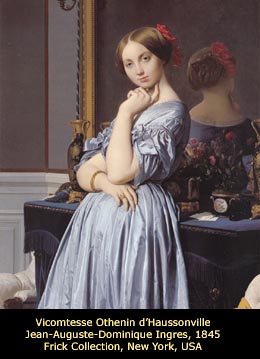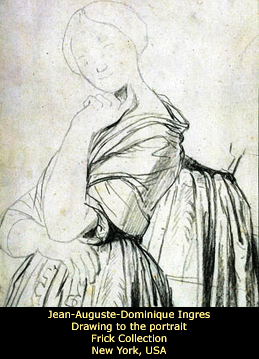Vicomtess Othenin d'Hausonville (Louise Albertine de Broglie)
Jean-Auguste-Dominique Ingres, 1845
French Neoclassicism
Frick Collection, New York, USA
The painter of the epoch of spectacular dresses of the most luxurious fabrics,
leader of French Neoclassical movement, Jean-Auguste-Dominique Ingres (1780 - 1867),
got his early academic training in nearby Toulouse Academy and from 1797 in Jacques-Louis
David's studio in Paris. He won the Prix de Rome in 1801, but because of
unstable political situation his departure for Italy was postponed until 1806.
He stayed in Italy until 1824, where after finishing his
four-year scholarship he painted historical scenes and portraits mainly for the members of the
French colony in Rome and Florence. Between 1820-1824 he was working on Raphaelesque
"Vow of Louis XIII" in Florence.
After returning to Paris in 1824 "Vow of Louis XIII" was exhibited
with great success at the Salon.
He received official honors, but his works were severely criticized by critics because
of his "Gothic" distortions.
In 1834 he accepted the directorship of the French Academy in Rome and returned
to Rome for seven years.
In 1841 he returned to Paris.
He painted big variety of mythological and historical scenes,
female nudes in imagined oriental settings but his main strength was portraiture.
Through portraits of ruling elite in France, aristocrats, politicians, wealthy sitters,
beautiful mistress and famous artists he showed the real image of the epoch he lived in.
However, his romance with portraiture started some years earlier, during his first visit in Villa
Medici (Italy) when to support himself he painted portraits of wealthy French travelers and aristocrats.
The outstanding example of his portrait art is a portrait of the Vicomtess d'Haussonville
(Louise Albertine de Broglie, 1845, Frick Collection, New York City).
The Vicomtess d'Haussonville was a grand daughter of famous Madame de Staël,
liberal novelist and essayist (nee Anne Louise Germaine Necker). She was married at
the age of eighteen to a diplomat,
writer and a member of the French Academy, Othenin de Cléron d'Haussonville.
She herself was also a writer and published a number of books, including
biographies of Robert Emmet and Lord Byron. For her time and her class she was
outspokenly educated, independent and liberal.
Her portrait by Ingres is considered
one of the finest portraits of the 19th century. It
was painted after his return to Paris from the second visit in Rome in 1841
(Signed and dated on the arm of the chair at lower left; INGRES 1845.).
The delicate and sensual style of the painting was greatly influenced by
portraits of his Renaissance idol, Italian painter Raphael Santi.
Preparatory studies inclusive many preliminary drawings (see one in the right panel),
including full-scale studies of the raised left arm, the head and its reflection in the mirror.
He appears to have surprised the young lady in the intimacy of her boudoir. Her elegant
figure is posed against an upholstered fireplace, having just discarded her
evening wrap and opera glasses.
She seems to be thinking about opera she had seen last evening.
Her blue silk gown, textile in vogue during the second half of the eighteenth
century and again in the mid-nineteenth century reflects the contemporary
fascination with Renaissance styles. The aura of sensuality of her dress
was obtained by using delicately shaded contours and a rhythmic flow of the brush.
The lace trimming on the bodice and exposed décolletage lightly emphasize the elegance of the Vicomtess dress.
The bracelet on her hand and the rings on her fingers probably with diamond, turquoise,
emerald, and aquamarine completes the rich attire of sitter.
The red ribbon in her hair seems to be the final touch Ingres added to the painting.
According to a letter written by Ingress to his friend, the finished work "aroused a
storm of approval" among her family and friends.
His elegant delineation and evocation of soft contours and folding of various textiles
and luxurious fabrics have inspired many artists (E. Degas, P. A. Renoir, H. Matisse,
P. Picasso) and costume designers (Versace).

